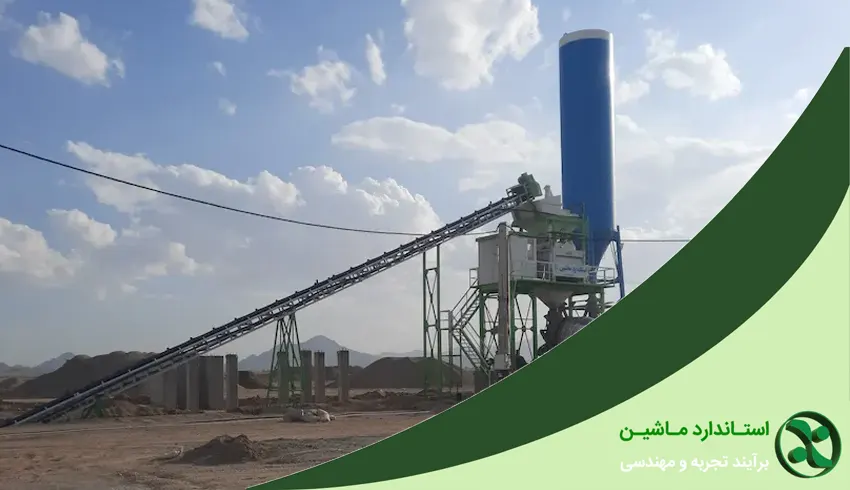Concrete batching plants are among the most critical and sensitive elements of construction and industrial projects. Continuous mechanical operations, the use of chemicals, and the transportation of large volumes of materials and electrical equipment make batching plants one of the highest-risk areas on any site.
In such environments, strict compliance with HSE (Health, Safety & Environment) standards not only safeguards personnel health but also significantly reduces costs related to project downtime, workplace incidents, and equipment damage. On the other hand, neglecting these principles can lead to irreversible human and financial losses.
In this article from Standard Machine, we will walk you through the key requirements, safety checklists, common hazards, and practical solutions for implementing HSE standards in the operation and maintenance of batching plants.
Key HSE Standards for Batching Plants
Given the mechanical, electrical, and chemical components involved, concrete batching plants must be equipped and managed according to stringent HSE standards. Adherence to these standards not only prevents accidents but also improves the long-term efficiency of the plant.
1. Use of Personal Protective Equipment (PPE)
All personnel must wear appropriate PPE according to their assigned tasks. For example:
-
The mixer operator must wear insulated gloves, ear protection, and dust goggles to guard against noise and concrete dust.
-
The silo operator working at height or in sensitive zones must use a safety harness, sturdy safety boots, and a certified hard hat.
-
Maintenance staff must wear heavy-duty gloves, safety goggles, and filter masks when dealing with chemicals or dust.

2. Ventilation and Dust Control
Installing extraction systems at the cement discharge points is essential to minimize airborne contaminants and protect workers’ respiratory health. Additionally, using bag filters in silos prevents fine cement dust from dispersing. Creating natural or forced airflow in enclosed spaces is another key measure for dust control and ensuring proper ventilation.
3. Electrical Safety
Critical HSE requirements include installing electrical panels with high IP ratings to prevent ingress of dust and moisture. Proper grounding (earthing) for the entire electrical system is required to avoid electric shocks. During maintenance or servicing, Lockout‑Tagout (LOTO) procedures must be enforced to prevent accidental machine start‑ups and ensure worker safety.
4. Mixer and Belt Safety
All moving parts and belts should be covered by standard metal guards to prevent accidental contact with limbs or clothing. Strategically located emergency stop buttons allow rapid system shutdown in case of danger. The operator should perform daily inspections to detect vibration, strange noises, or oil leaks and address them promptly.
5. Signage and Training
Clear warning signs in all hazardous and sensitive zones are vital to keep personnel aware of environmental risks. Comprehensive training for operators and supervisors on batching-specific hazards and emergency response is crucial. Implementing Safe Work Procedures (SWP) for each task ensures that operations are conducted according to HSE protocols.
6. HSE Supervision
An assigned HSE supervisor must be present during each work shift to monitor and evaluate all activities. Daily safety inspection forms help identify potential issues before an incident occurs. Thorough documentation of incidents, near‑misses, and corrective actions is essential for later analysis and prevention of repeat errors.
Daily Safety Checklist for Operating a Batching Plant
(A sample checklist covering key control points)
| Item | Ideal Condition | Actual Condition | Corrective Actions | Inspector Sign-off |
|---|---|---|---|---|
| Electrical cables | No cuts or loose connections | … | … | … |
| PPE (Helmet, gloves, mask, boots, goggles) | Full standard gear | … | … | … |
| Emergency stop system | Full shutdown functionality | … | … | … |
| Dust levels in silos and mixer | Below allowable limit | … | … | … |
| Ventilation system | Active and unobstructed | … | … | … |
| Conveyor guards | Properly installed and intact | … | … | … |
| Warning signs | Present at all hazard points | … | … | … |
| Machine off during maintenance | Correct LOTO implementation | … | … | … |
| Chemical leaks | No oil or additive spills | … | … | … |
| Noise level | Below 85 dB | … | … | … |
Checklist instructions:
-
Inspect and complete this form before each shift.
-
Report any hazard or defect immediately to the supervisor and HSE officer.
-
The safety supervisor should review the form weekly for completeness and accuracy.
Legal Requirements & Safety Responsibilities
Compliance with HSE in batching plants isn’t just recommended—it’s legally mandated. Ignoring these obligations may result in penalties, compensation claims, or even imprisonment.
Regulatory Requirements (e.g., Ministry of Labor & Social Welfare)
-
Mechanical and electrical equipment must be certified by standard regulatory bodies.
-
Workers must receive both general and specialized safety training and hold valid certifications.
-
Safety distances, isolation measures, and guards for moving parts are mandatory.
Responsibilities of the Batching Operator
-
Full knowledge of machine operation and emergency procedures.
-
Daily equipment inspections per checklist.
-
Immediate reporting of technical defects or safety risks.
Duties of the HSE Observer
-
Drafting and updating batching‑specific safety instructions.
-
Periodic inspections of equipment and safety conditions.
-
Documenting and analyzing incidents and suggesting corrective actions.
-
Ensuring fire-fighting equipment, first-aid kits, and emergency exits are available.
Contractor & Employer Obligations
-
Provide proper PPE and training to all staff.
-
Maintain a safe and compliant physical infrastructure for the batching plant.
-
Purchase liability and accident insurance for operators and technicians.
-
Legal accountability in the event of accidents caused by negligence.
Emergency Management & Crisis Response in Batching
Heavy mechanical equipment, electrical sources, cement silos, and chemicals make batching plants high-risk environments. Proper planning and training help minimize damage and ensure swift response.
1. Fire in Electrical Equipment or Material Storage
Common causes: short circuits, overheating mixer or belts, oil or flammable material leaks.
Safety measures: use CO₂ or dry powder extinguishers, immediately isolate power, evacuate area, notify fire services.
2. Electric Shock to Operator or Technician
Common causes: exposed wiring, moisture in connections, earthing faults.
Response steps: Do not touch the victim directly, cut power at source, use wood or plastic to separate, call emergency services and administer first aid (CPR).
3. Cement, Dust, or Additive Spills
Risks: respiratory irritation, slips and falls, chemical reactions on skin or eyes.
Immediate actions: wear filter masks and safety goggles, rinse skin/eyes immediately, isolate and clean the spill site, report the incident in writing.
4. Belt or Silo Structural Failure
Warning signs: abnormal noise or severe vibration, visible cracks or deformation, shifting or tilting.
Response: stop operations immediately, avoid the suspicious area, contact repair team and structural engineer.
5. General Emergency Actions
-
Activate alarms or public announcement systems
-
Evacuate along designated escape routes
-
Assemble at safe gathering points
-
Deploy a rapid response team and document the incident

Benefits of Rigorous HSE Implementation
-
Reduces incidents and downtime
-
Enhances worker morale and retention
-
Extends the lifespan of machinery and equipment
-
Improves concrete quality
-
Minimizes legal fines and compliance issues
-
Boosts brand reputation and competitiveness in tenders and contracts

